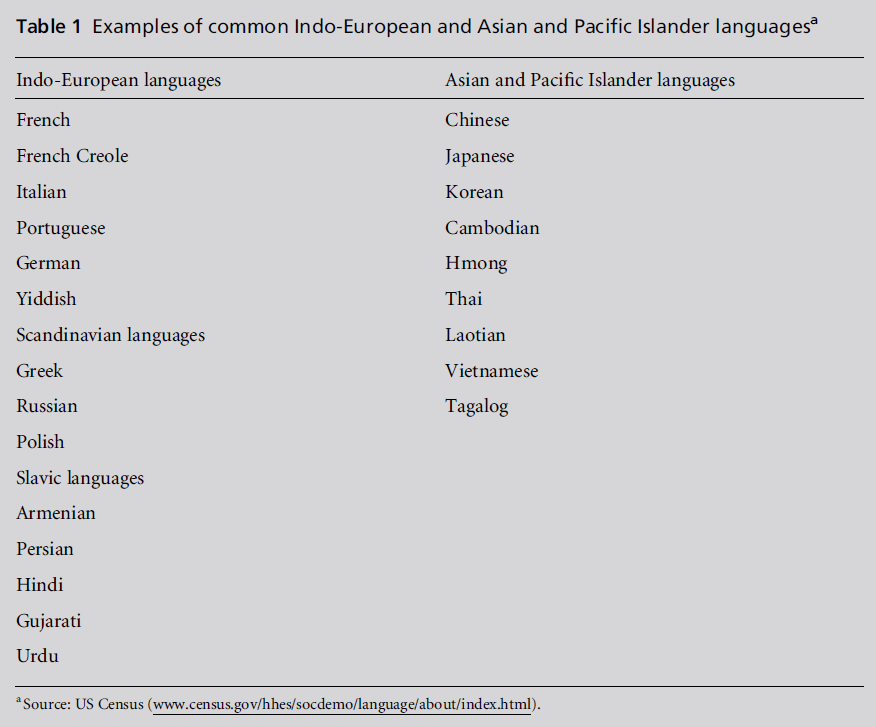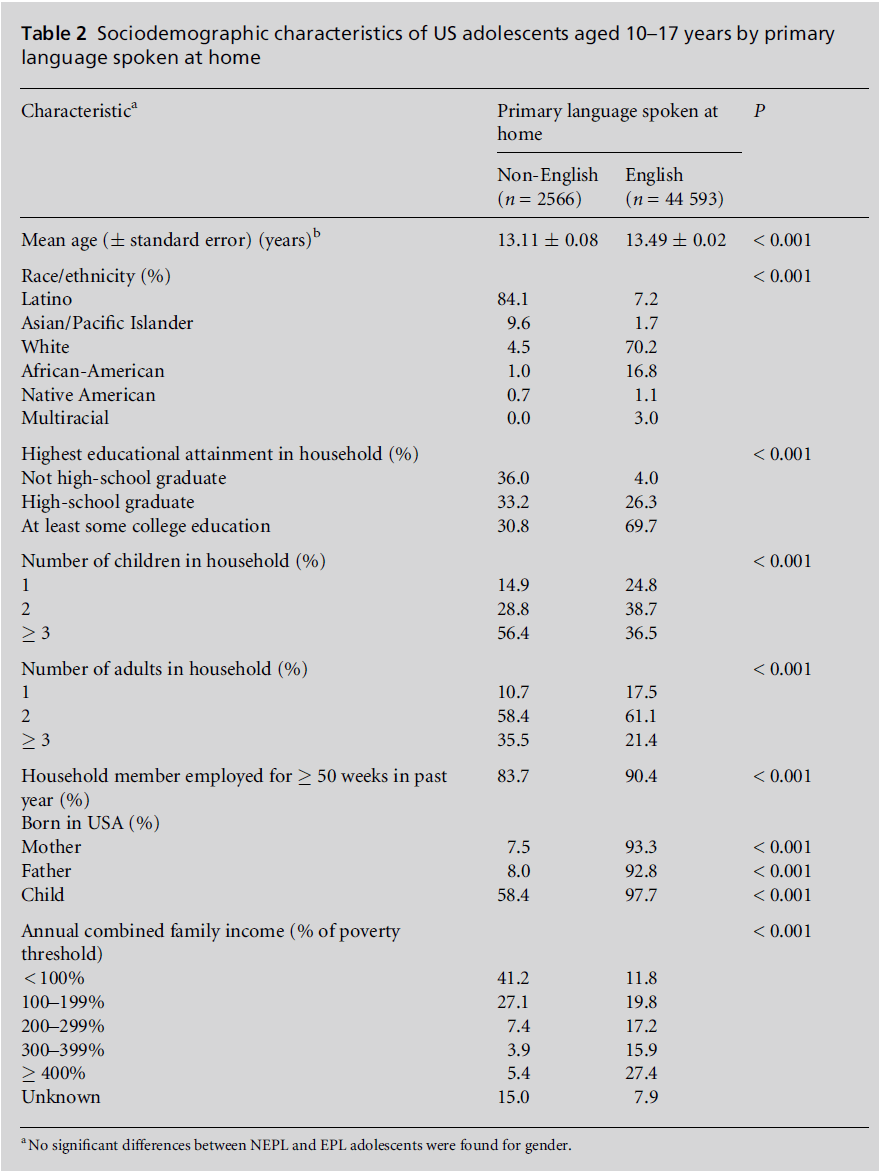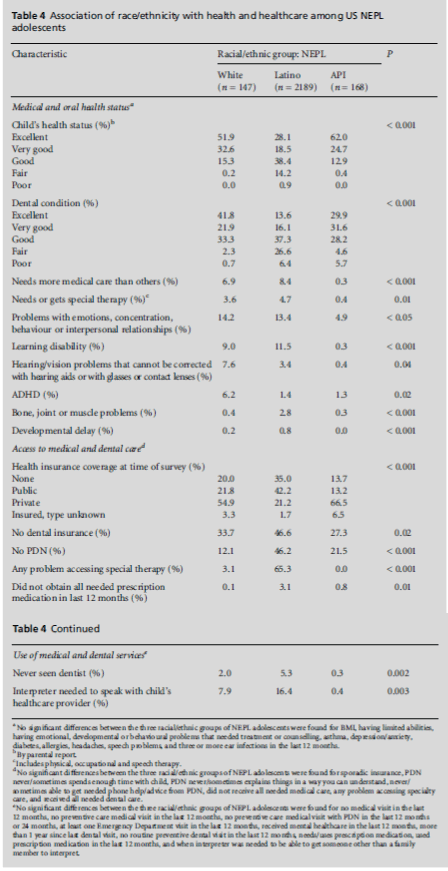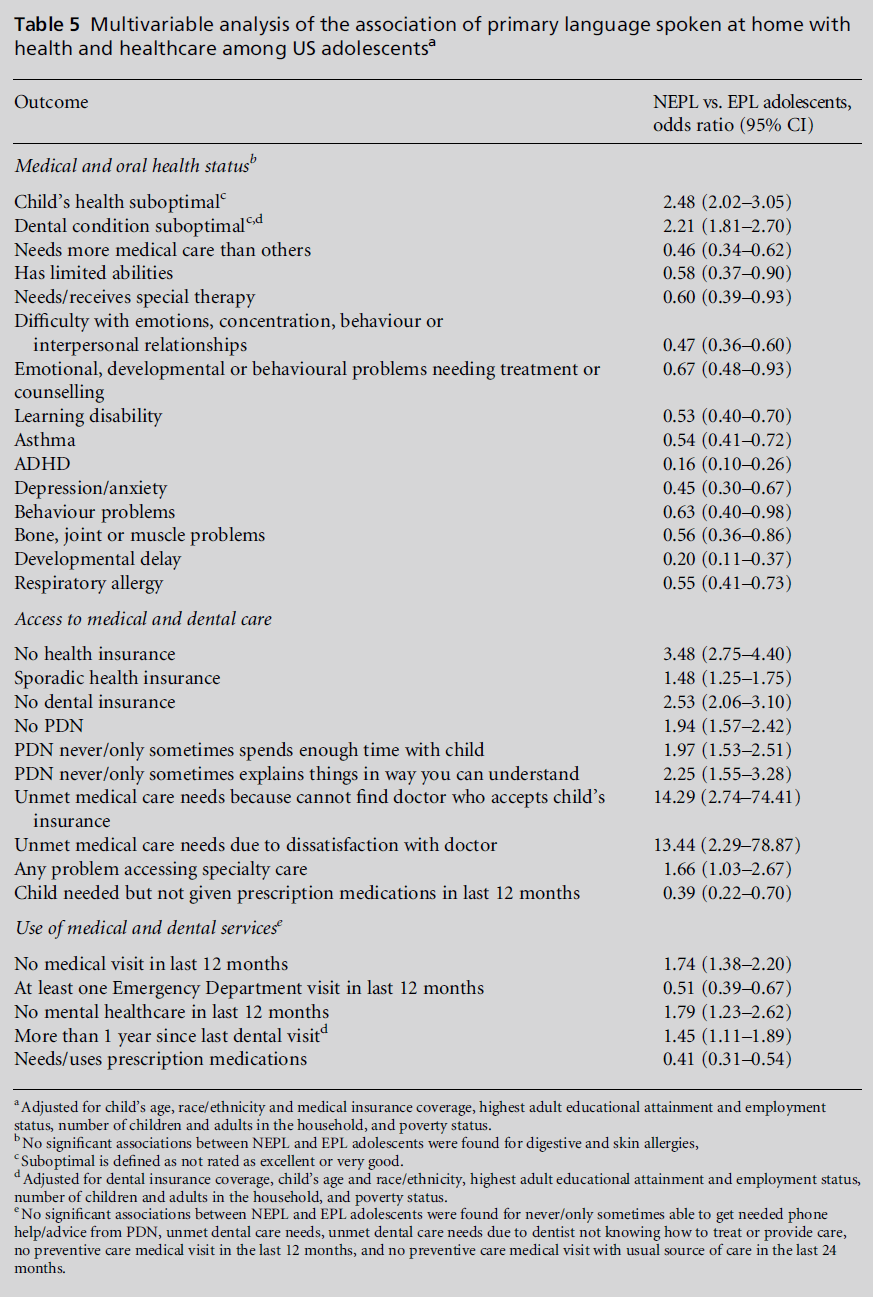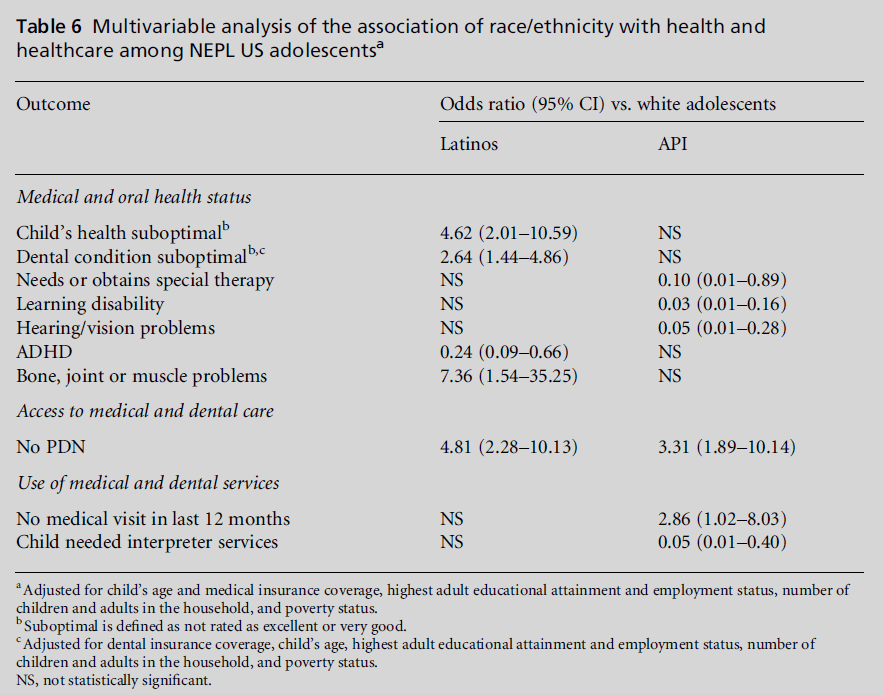Key words
adolescent, healthcare disparities, language,
minority groups
Introduction
Approximately 20% of the US population, or over
59 million people, speak a non-English primary language
(NEPL) at home (American Community Survey,
2010a). Spanish is the most common NEPL spoken at
home (13%), followed by other Indo-European (4%)
and Asian/Pacific Islander (API) languages (3%) (see
Table 1) (American Community Survey 2010a). Children
account for 11.8 million NEPL Americans (American
Community Survey, 2010b), with adolescents
aged 10–17 years representing almost 50% of the
paediatric population (US Census Bureau, 2012).
Most research into paediatric disparities has focused
on Latino parents, based on language of interview,
primary language at home or English proficiency, or
on specific health and healthcare indicators, such as
prevalence of a medical home, a usual source of care,
timeliness of routine and sick care, access to healthcare
and insurance, an asthma diagnosis, health status, and
dental service utilisation (DeCamp et al, 2011; Flores
et al, 1998; Galbraith et al, 2008; Greek et al, 2006; Hahm et al, 2008; Mosnaim et al, 2007; Noyce et al,
2009; Yu et al, 2006). Only one study has comprehensively
examined health and healthcare disparities
in NEPL children (Flores and Tomany-Korman,
2008).
Previous studies suggest that adolescents experience
unique disparities (Adams et al, 2009; Alexandre
et al, 2009; Van Wie et al, 2008;Wen, 2007). In a study
of US children, adolescents were found to be more
likely to have poorer parent-rated health than younger
children (Wen, 2007). One Californian study examined
disparities in three healthcare indicators for three
racial/ethnic minority groups of adolescents, based on
language use at home (Hahm et al, 2008), but there
are no published studies that have comprehensively
examined health and healthcare disparities in NEPL
adolescents. The aim of the present study was therefore
to comprehensively examine disparities in health
and healthcare in a nationally representative sample of
NEPL adolescents.
Table 1 :Examples of common Indo-European and Asian and Pacific Islander languagesa
Methods
Data source
The 2003 National Survey of Children’sHealth (NSCH)
was a cross-sectional, random-digit-dial household
telephone survey conducted by the National Center
for Health Statistics (Blumberg et al, 2005). The
NSCH’s purpose was to produce national and state
estimates of various physical, emotional and behavioural
health indicators for children aged 0–17 years.A
total of 102 353 child-level interviews were completed
between January 2003 and July 2004. Parents or guardians
(hereafter collectively referred to as parents)
who were most knowledgeable about the health and
healthcare of children in the household were the
survey respondents. A child was randomly selected
from the household for the survey. The NSCH was
only conducted in English or Spanish, so adolescents
whose parents had limited English or Spanish proficiency
and did not speak either language were not
included. After an experienced Spanish translator had
translated the English questionnaire into Spanish, the
Spanish questionnaire was reviewed for accuracy and
cultural appropriateness (Blumberg et al, 2005). Experienced
bilingual interviewers administered the
Spanish questionnaire. The survey had an overall response
rate of 55.3%. NSCH sampling weights adjust
for households with multiple telephone lines and
provide multiple adjustments for non-response bias,
including adjustments for unknown household status
and eligibility, households with multiple children, and
non-coverage of households without telephones. This
was a secondary database analysis without personal
identifiers, so the study was exempt from institutional
review board approval. To address the possible ethical
concerns associated with not including individuals
with limited proficiency in English or Spanish, the as
yet unreleased 2011 NSCH was conducted in four
additional languages (National Opinion Research Center,
undated).
Definitions and measures
Adolescents were defined as aged 10 to 17 years, which
is consistentwith the Society of Adolescent Health and
Medicine’s definition of adolescence as beginning at
10 years of age (Society for Adolescent Medicine,
1995).
There were two independent variables of interest,
namely household primary language and race/ethnicity.
NEPL and EPL households were identified by
asking the respondent ‘What is the primary language
spoken in your home?’ Children in households where
Spanish or another non-English language was the
primary language were classified as NEPL. Parents identified the child’s race/ethnicity. Private insurance
included any type of non-public health insurance,
such as Health Maintenance Organization (HMO),
employer-sponsored, or self-purchased health insurance
(Centers for Disease Control and Prevention;
www.cdc.gov/nchs/data/slaits/NSCH_Questionnaire.
pdf). Public insurance included any governmentassistance
health insurance programme, such asMedicaid
(for low-income or disabled individuals), or state
health-insurance programmes, such as the Children’s
Health Insurance Program (CHIP) (for low-income
children not qualifying for Medicaid) (Centers for
Disease Control and Prevention; www.cdc.gov/nchs/
data/slaits/NSCH_Questionnaire.pdf).
The study outcomes consisted of 40 measures encompassing
three domains, namely medical and oral
health status, access to care and use of services. Body
mass index (BMI) was calculated using parental reports
of the adolescent’s height and weight. Responses
under the medical and oral health status section reflect
parental responses to diagnosed conditions. A personal
doctor or nurse (PDN) refers to a regular
healthcare provider who knew the child’s health and
medical history. For certain health status variables, the
NSCH asked about need and use at the same time (see
Box 1).
Analyses
All analyses were performed using STATA 10 to
account for the complex sample design of NSCH and
to produce weighted estimates (StataCorp, 2007). The
sample was limited to index adolescent children aged
10–17 years.
The sociodemographic characteristics of NEPL and
EPL adolescents and their households were compared,
followed by bivariate analyses to identify associations
between primary language at home and variables in
three different domains, namely medical and oral health
status, access to care and use of services. Among NEPL
adolescents, associations between race/ethnicity and
their outcomes were examined with bivariate analyses that compared outcomes for Latino and Asian/Pacific
Islander (API) adolescents with those for white adolescents.
Pearson’s X2 test statistic was used to test for
independence between primary language categories or
racial/ethnic groups and discrete factors.
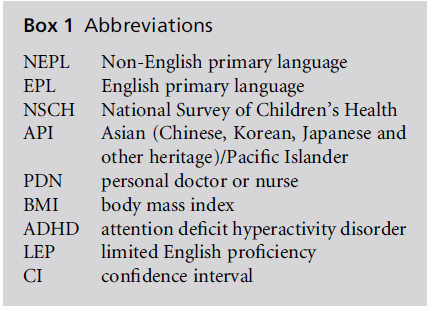
Multivariable logistic regression analyses were
performed to examine adjusted associations between
the primary language spoken at home and variables
within the three domains, as well as racial/ethnic
disparities among NEPL adolescents in the identical
outcomes. Covariates in each model included the
adolescent’s age, race/ethnicity (except in analyses of
racial/ethnic disparities) and insurance coverage (except
when this was the outcome), employment status
and highest adult educational attainment in the
household, the number of adults and children in the
household, and the household poverty status (using
the federal poverty threshold for a family of four at the
time of the survey). All multivariable analyses employed
stepwise procedures followed by forced entry
of the above-mentioned eight covariates. The initial
alpha-to-enter was 0.15, and the final alpha-to-enter
was 0.05.
Results
Sociodemographic data
NEPL adolescents were slightly younger than EPL
adolescents and significantly more likely to be Latino
or API (see Table 2). NEPL parents were nine times
less likely to be high-school graduates. NEPL household
members were less likely to have been consistently
employed in the past year. NEPL parents and
adolescents were substantially more likely to be foreignborn.
Higher proportions of NEPL households had an
annual combined family income that was less than
100% of the federal poverty threshold. There was no
association between household primary language and
gender.
Medical and oral health status
Compared with EPL adolescents, higher proportions
of NEPL adolescents had suboptimal (neither excellent
nor very good) health status and dental condition,
and were overweight or obese (see Table 3). Parents of
NEPL adolescents reported a lower prevalence of 12
physical, emotional and behavioural conditions or
concerns, but there were no associations between
household primary language and the remaining eight
conditions.
Access to medical and dental care
Higher proportions of NEPL adolescents than of EPL
adolescents were uninsured, had sporadic health insurance coverage, and had no dental insurance (see
Table 3). Over 40% of NEPL adolescents had no
personal doctor or nurse (PDN). Among adolescents
with a PDN, NEPL parents were more likely than EPL
parents to report that the PDN never/sometimes
spends enough time with the adolescent, clearly explains
things or provides needed telephone help/advice.
The reason for unmet medical needs was significantly
more likely to be lack of insurance for NEPL adolescents
and health-plan problems for EPL adolescents.
About 50% of NEPL adolescents had problems
obtaining specialty care and accessing special therapy.
NEPL adolescents were more likely not to receive all of
the dental care they required and to have unmet dental
needs due to health-plan problems. No other significant
differences were noted for the other five indicators.
Use of medical and dental services
NEPL adolescents were significantly more likely than
EPL adolescents to have made no medical or preventive
medical visits in the past year (see Table 3). For
those with a PDN, NEPL adolescents were more likely
to have made no preventive visit in the past 2 years.
In contrast, EPL adolescents were more likely to have
made an Emergency Department visit, a mental healthcare
visit, to need or use prescription medications, and
of those who needed or used prescription medications
to have used prescription medications in the past year.
NEPL adolescents were significantly more likely to
have never seen a dentist, to have gone for more than 1
year since the last dental visit, and to have had no
routine preventive dental care in the past year.
NEPL, race/ethnicity, and medical and
oral health
For Latino NEPL adolescents, over 50% had suboptimal
health, almost 75% had suboptimal dental
health, and nearly 50% were overweight or obese (see
Table 4). Compared with white and Latino NEPL
adolescents, lower proportions of API NEPL adolescents
needing more medical care than others, requiring
special therapy, more difficulty with emotions,
concentration, behaviour or interpersonal relationships,
or had a learning disability. Latino NEPL adolescents
more often had bone, joint or muscle
problems and developmental delay more often than
white and API NEPL adolescents. NEPL white adolescents
had a higher prevalence than NEPL Latinos
and APIs of hearing or vision problems and attention
deficit hyperactivity disorder (ADHD). No other
disparities were noted among NEPL adolescents for
the other ten conditions.
Table 2:Sociodemographic characteristics of US adolescents aged 10ÃÆÃâÃââÃÆââ¬Å¡Ã¢ââ¬Å¡Ã¬ÃÆââ¬Å¡Ã¢ââ¬Ã
â17 years by primary
language spoken at home.
NEPL, race/ethnicity, and access to
medical and dental care
Compared with white and API NEPL adolescents,
higher proportions of Latino NEPL adolescents were
uninsured, had no dental insurance and had no PDN
(see Table 4). Higher rates ofNEPL Latinos than NEPL white and APIs had difficulty accessing special therapy
and had not received all of the prescription medications
that they needed in the past year. No other
significant access differences were noted for the other
seven access indicators.
Table 3:Association of primary language spoken at home with health and healthcare
among US adolescents
Table 4:Association of race/ethnicity with health and healthcare among US NEPL
adolescents.
NEPL, race/ethnicity, and use of medical
and dental services
More NEPL Latinos than white adolescents had never
seen a dentist (see Table 4). NEPL Latinos were
substantially more likely than NEPL white and APIs
to require an interpreter to speak with the adolescent’s
healthcare provider. No other disparities were found
for the other 11 indicators.
Multivariable analyses
Compared with EPL adolescents, NEPL adolescents
were twice as likely not to have excellent or very good
medical or dental health status (see Table 5). However,
NEPL adolescents were less likely than EPL adolescents
to have 13 different physical, emotional and
behavioural conditions or concerns.
NEPL adolescents experience multiple disparities in
barriers to accessing medical and dental care (see
Table 5). Compared with EPL adolescents, NEPL
adolescents are more likely to have no health insurance,
sporadic health insurance and no dental
insurance. NEPL adolescents are about twice as likely
to have no PDN, and parents of NEPL adolescents
report that the PDN does not spend enough time with
the adolescent and does not explain things clearly.
NEPL adolescents were also substantially more likely
to have unmet medical needs due to difficulty in finding
a doctor who accepted their insurance, and due to
being dissatisfied with the doctor. NEPL adolescents
were more likely to have problems in accessing specialty
care. For only one access-to-care indicator,
namely needing but not receiving prescriptions in
the past year, did NEPL adolescents have lower odds
compared with EPL adolescents. Compared with EPL adolescents, NEPL adolescents were more likely to
have had no medical, dental or mental healthcare visit
in the past year, but less likely to have had Emergency
Department visits and to have needed or used prescription
medications.
Among NEPL adolescents, certain disparities were
noted for Latinos and APIs, compared with white
adolescents (see Table 6). NEPL Latinos had higher
odds of not having excellent or very good health, bone,
joint or muscle problems, and dental health. NEPL
Latinos were less likely to have ADHD, whereas NEPL
APIs were less likely to need or receive special therapy,
and to have a learning disability and hearing or vision
problems. Both NEPL Latino and API adolescents
were substantially more likely than white adolescents
not to have a PDN (see Table 6). NEPL API adolescents
were about three times more likely than white
adolescents to have made no medical visit in the past
year, but substantially less likely to need interpreter
services.
Discussion
The NSCH is the largest national data set containing
information on the primary language spoken at home.
To our knowledge, this study is the first to comprehensively
examine the association of NEPL with
health and healthcare in a nationally representative
sample of US adolescents. It reinforces the importance
of examining adolescents separately from children, as
the type of health and healthcare disparities that NEPL
adolescents experience differ from those experienced by children. Compared with EPL children, NEPL
children had higher risks of not receiving preventive
medical care and of having unmet dental needs,
whereas these measures for NEPL and EPL adolescents
did not differ (Flores and Tomany-Korman, 2008).
Adolescents require less frequent preventive medical
visits for immunisations and health maintenance than
children, which may partially account for the differences
between NEPL children and adolescents. With
regard to dental care, NEPL and EPL adolescents
experience the same difficulties in obtaining dental
care due to lack of insurance, restricted dental benefits
for those with public insurance, and the limited number
of paediatric dentists, and also of paediatric dentists
who accept public insurance (Paradise, 2009).
Table 5:Multivariable analysis of the association of primary language spoken at home with
health and healthcare among US adolescentsa.
Table 6:Multivariable analysis of the association of race/ethnicity with health and
healthcare among NEPL US adolescentsa.
The study findings reveal that NEPL adolescents are
at particularly high risk of being uninsured. Previous
research documents the finding that adolescents are
significantly more likely to be uninsured than younger
children (Fox andMcManus, 2009). For children of all
ages, parental language barriers have been shown to be
a major risk factor for being uninsured (Flores and
Tomany-Korman, 2008; Yu et al, 2006). In addition,
research demonstrates that many NEPL children who
are eligible for insurance are not enrolled due to parental
misperceptions about insurance and healthcare (Flores et al, 2005a; Rhee et al, 2009). There is national
support for enhancing insurance coverage of NEPL
children, with almost 75% of Americans believing that
documented immigrant children should be provided
with health insurance coverage (Attias, 2009). Increasing
NEPL adolescents’ access to insurance may require
community outreach and enrolment and also interventions
by community health workers (Flores et al,
2005b).
The findings demonstrated that NEPL adolescents
are more likely to have unmet medical care needs
because they cannot find a physician who accepts their
insurance or because of dissatisfaction with physicians,
which (to our knowledge) have not been reported elsewhere.
Insurance coverage may explain NEPL adolescents’
limited access to physicians. In California,
many Spanish-speaking Medicaid patients with limited
English proficiency (LEP) could not obtain care
from bilingual physicians due to the limited number
of Medicaid patients for whomphysicians werewilling
to provide care (Yoon et al, 2004). Reimbursement rates
and delays can affect the number of providers accepting
public insurance, such as Medicaid (Cunningham
and Nichols, 2005; Cunningham and O’Malley, 2009).
Language barriers aside, reasons for parental dissatisfaction
with physician care include lack of involve- ment in healthcare decisions, not understanding the
culture, physician waiting times, insufficient time
spent with the physician, and delays in receiving sick
and preventive care (Flores et al, 1998; Galbraith et al,
2008; Greek et al, 2006; Ngo-Metzger et al, 2004). Loan
repayment programmes can increase the number of
physicians who accept public insurance and work in
medically underserved areas (Pathman et al, 2004). In
addition, professional medical interpreters, telephone
interpreters and bilingual providers have been reported
to reduce language barriers and enhance communication
and patient satisfaction for NEPL patients and
families (Crossman et al, 2010; Flores, 2005).
Our results indicate that NEPL adolescents are
significantly more likely than EPL adolescents not to
have had a mental healthcare visit. NEPL adolescents
were also less likely to have an emotional, developmental
or behavioural problem that required treatment
or counselling. Cultural influences, such as the
social stigma attached to mental illness that has been
observed in several Asian cultures, could account for
the lower likelihood of parents reporting a mental
health problem (Kramer et al, 2002). Furthermore,
Asians are more likely to express mental health problems
as physical complaints, which could further
account for the lack of mental healthcare use (Kramer
et al, 2002). Language difficulties, long waits for
appointments with mental health providers who accept
Medicaid, frequent high out-of-pocket costs for
mental health visits, and limited availability of services
after school and at weekends may contribute to the
lower rates of mental healthcare visits by NEPL adolescents
(Pfefferle, 2007; Yeh et al, 2003). In addition,
LEP in adults has been associated with lower rates of
mental healthcare use (Sentell et al, 2007). Educating
adolescent providers about the identification and treatment
of mental health disorders in different races/
ethnicities, and increasing the number and availability
of bilingual Medicaid mental health providers, may
increase the identification of mental health problems
and mental healthcare access for NEPL adolescents.
Limitations
Certain study limitations should be noted. The NSCH
measured only the primary language spoken at home,
not the primary language spoken by the adolescent.
In addition, there was no assessment of parents’ or
adolescents’ proficiency in English. LEP is a better indicator
of language barriers than the primary language
spoken at home, when examining health and healthcare
outcomes (Flores et al, 2005c). Thus themagnitude
of the health and healthcare disparities documented in
this NSCH analysis may be even greater for adolescents
who are LEP or who have LEP parents.
Parents who spoke a language other than English or
Spanish and had either limited English or Spanish
proficiency were not included. As a result, it is likely
that a larger proportion of NEPL LEP parents of Latino
adolescents were included in the NSCH, compared
with NEPL LEP parents of API adolescents, which may
have affected the study findings. Therefore it may not
be possible to generalise the findings to the entire
NEPL adolescent population in the USA, and they
may underestimate disparities in API and non-Latino
NEPL adolescents. In a previous study of NEPL children
in the USA, calculations using US census data
suggested that NSCH data should generalise to 93.5%
of NEPL US households with children (aged 0–17
years) (Flores and Tomany-Korman, 2008).
Certain disparities might be influenced by racial/
ethnic, language and LEP or cultural differences in
identifying and assessing medical and dental health
status and unmet healthcare needs (Alexandre et al,
2009; Crossman et al, 2010; Kramer et al, 2002;
Mosnaim et al, 2007). Given that all estimates were
derived from parental reports, and not from adolescent
or healthcare provider reports or laboratory
data, response bias may also affect the NSCH data.
Adolescents might have responded differently to questions
on health status and access to care, depending on
acculturation level and parental presence during the
interview. The sample size of NEPL API adolescents (n
= 168) was relatively small, making it difficult to
produce statistically reliable estimates; over-sampling
of NEPL API adolescents in larger data sets and confirmation
of study findings are essential.
The NSCH did not collect information on the
citizenship status of adolescents and parents. Nativity
status, immigration status and date of immigration
were not included in the analysis. Non-citizen immigrant
children and citizen children with immigrant
parents are more likely to be uninsured and to have
poorer access to care (Ku, 2007; Yu et al, 2004).
Additional studies are needed to determine the impact
of NEPL, LEP, and adolescent and parent citizenship
status on adolescent health and healthcare.
Conclusions
The study findings have several potential implications
for research, practice and policy. Insurance coverage
and health policy changes that increase healthcare
provider access may help to eliminate the barriers
experienced by NEPL adolescents. Identifying, monitoring
and eliminating NEPL adolescent disparities
will require healthcare systems and national and state
agencies to routinely document the primary language
spoken at home and LEP status for patients. A recent
national survey reported that only around 50% of the hospitals collect information on language preference
(Regenstein and Sickler, 2006). Many hospitals do not
have a standard protocol for the collection or documentation
of language preferences and English proficiency,
resulting in incorrect or incomplete information
(Hasnain-Wynia et al, 2004). Use and reimbursement
of professional medical interpreters, educating healthcare
providers about working with interpreters, and
increasing the number of bilingual providers, all have
the potential to improve access, use of services and the
quality of care for NEPL and LEP adolescents and their
families (Crossman et al, 2010; Flores, 2005; Jacobs
et al, 2004; McEvoy et al, 2009).
ACKNOWLEDGEMENTS
We thank Rosa Avila for her assistance with accessing
the database and her input on early drafts of the
manuscript.
The findings of this study were presented in part at
the Third National Leadership Summit on Eliminating
Racial and Ethnic Disparities in Health on 25
February 2009 at National Harbor, Maryland, the
annual meeting of the Paediatric Academic Societies
on 2 May 2009 in Baltimore, Maryland, and the
AcademyHealth Annual Research Meeting on 29 June
2009 in Chicago, Illinois.
This project was supported in part by the Network
for Multicultural Research on Health and Healthcare,
Department of Family Medicine, David Geffen School
of Medicine, UCLA, funded by the Robert Wood
Johnson Foundation.
CONFLICTS OF INTEREST
None.
References
- Adams SH, Husting S, Zahnd E et al (2009) Adolescent preventive services: rates and disparities in preventive health topics covered during routine medical care in a California sample. Journal of Adolescent Health 44: 536ÃÆÃâÃââÃÆââ¬Å¡Ã¢ââ¬Å¡Ã¬ÃÆââ¬Å¡Ã¢ââ¬Ã
â45.
- Alexandre PK, Martins SS and Richard P (2009) Disparities in adequate mental health care for past year major depressive episodes among Caucasian and Hispanic youths. Psychiatric Services 60:1365ÃÆÃâÃââÃÆââ¬Å¡Ã¢ââ¬Å¡Ã¬ÃÆââ¬Å¡Ã¢ââ¬Ã
â71.
- American Community Survey (2010a). 1-Year Estimates. www.factfinder2.census.gov/faces/tableservices/jsf/pages/productview.xhtml?pid=ACS_10_1YR_DP02&prodType=table
- American Community Survey (2010b) 1-Year Estimates. www.factfinder2.census.gov/faces/tableservices/jsf/pages/productview.xhtml?pid=ACS_10_1YR_S1603&prodType=table
- Attias M (2009) Washington Health Policy Week in Review Poll: Americans favor strongest possible, low-cost childrenÃÆÃâÃââÃÆââ¬Å¡Ã¢ââ¬Å¡Ã¬ÃÆââ¬Å¡Ã¢ââ¬Å¾Ã¢s health coverage. New York: The Commonwealth Fund. www.commonwealthfund.org/Content/Newsletters/Washington-Health-Policy-in-Review/2009/Aug/August-17ÃÆÃâÃââÃÆââ¬Å¡Ã¢ââ¬Å¡Ã¬ÃÆââ¬Å¡Ã¢ââ¬Ã
â2009/Americans-Favor-Strongest-Possible-LowCost-Childrens-Health-Coverage.aspx (accessed 8 September2012).
- Blumberg SJ, Olson L, Frankel MR et al (2005) Design and Operation of the National Survey of ChildrenÃÆÃâÃââÃÆââ¬Å¡Ã¢ââ¬Å¡Ã¬ÃÆââ¬Å¡Ã¢ââ¬Å¾Ã¢s Health, 2003. Vital and Health Statistics, Series 1, Number 43. Washington, DC: Centers for Disease Control and Prevention, US Department of Health and Human Services.
- Crossman KL, Wiener E, Roosevelt G et al (2010) Interpreters: telephonic, in-person interpretation and bilingual providers. Pediatrics 125:e631ÃÆÃâÃââÃÆââ¬Å¡Ã¢ââ¬Å¡Ã¬ÃÆââ¬Å¡Ã¢ââ¬Ã
â8.
- Cunningham PJ and Nichols LM (2005) The effects of Medicaid reimbursement on the access to care of Medicaid enrollees: a community of perspective. Medical Care Research and Review 62:676ÃÆÃâÃââÃÆââ¬Å¡Ã¢ââ¬Å¡Ã¬ÃÆââ¬Å¡Ã¢ââ¬Ã
â96.
- Cunningham PJ and OÃÆÃâÃââÃÆââ¬Å¡Ã¢ââ¬Å¡Ã¬ÃÆââ¬Å¡Ã¢ââ¬Å¾Ã¢Malley AS (2009)Doreimbursement delays discourage Medicaid participation by physicians? Health Affairs 28:w17ÃÆÃâÃââÃÆââ¬Å¡Ã¢ââ¬Å¡Ã¬ÃÆââ¬Å¡Ã¢ââ¬Ã
â28.
- DeCamp LR, Choi H and Davis MM (2011) Medical home disparities for Latino children by parental language of interview. Journal of Health Care for the Poor and Underserved 22:1151ÃÆÃâÃââÃÆââ¬Å¡Ã¢ââ¬Å¡Ã¬ÃÆââ¬Å¡Ã¢ââ¬Ã
â66.
- Flores G (2005) The impact of medical interpreter services on the quality of health care: a systematic review. Medical Care Research and Review 62:255ÃÆÃâÃââÃÆââ¬Å¡Ã¢ââ¬Å¡Ã¬ÃÆââ¬Å¡Ã¢ââ¬Ã
â99.
- Flores G and Tomany-Korman SC (2008) The language spoken at home and disparities in medical and dental health, access to care, and use of services in US children. Pediatrics 121:e1703ÃÆÃâÃââÃÆââ¬Å¡Ã¢ââ¬Å¡Ã¬ÃÆââ¬Å¡Ã¢ââ¬Ã
â14.
- Flores G, Abreu M, OlivarMAet al (1998) Access barriers to health care for Latino children. Archives of Pediatrics and Adolescent Medicine 152:1119ÃÆÃâÃââÃÆââ¬Å¡Ã¢ââ¬Å¡Ã¬ÃÆââ¬Å¡Ã¢ââ¬Ã
â25.
- Flores G, AbreuMand Brown V (2005a) How Medicaid and the State ChildrenÃÆÃâÃââÃÆââ¬Å¡Ã¢ââ¬Å¡Ã¬ÃÆââ¬Å¡Ã¢ââ¬Å¾Ã¢s Health Insurance Program can do a better job of insuring uninsured children: the perspectives of parents of uninsured Latino children. Ambulatory Pediatrics 5:332ÃÆÃâÃââÃÆââ¬Å¡Ã¢ââ¬Å¡Ã¬ÃÆââ¬Å¡Ã¢ââ¬Ã
â40.
- Flores G, AbreuMand Chaisson CE (2005b) A randomized, controlled trial of the effectiveness of community-based case management in insuring uninsured Latino children. Pediatrics 116:1433ÃÆÃâÃââÃÆââ¬Å¡Ã¢ââ¬Å¡Ã¬ÃÆââ¬Å¡Ã¢ââ¬Ã
â41.
- Flores G, Abreu M and Tomany-Korman SC (2005c) Limited English proficiency, primary language at home, and disparities in childrenÃÆÃâÃââÃÆââ¬Å¡Ã¢ââ¬Å¡Ã¬ÃÆââ¬Å¡Ã¢ââ¬Å¾Ã¢s health care: how language barriers are measured matters. Public Health Reports 120:418ÃÆÃâÃââÃÆââ¬Å¡Ã¢ââ¬Å¡Ã¬ÃÆââ¬Å¡Ã¢ââ¬Ã
â30.
- Fox HB and McManus MA (2009) Health Reform and Adolescents. www.thenationalalliance.org/pdfs/Brief3.%20Health%20Reform%20and%20Adolescents.pdf
- Galbraith AA, Semura JI, McAninch-Dake RJ et al (2008) Language disparities and timely care for children in managed care Medicaid. American Journal of Managed Care 14:417ÃÆÃâÃââÃÆââ¬Å¡Ã¢ââ¬Å¡Ã¬ÃÆââ¬Å¡Ã¢ââ¬Ã
â26.
- Greek AA, Kieckhefer GM, Kim H et al (2006) Family perceptions of the usual source of care among children with asthma by race/ethnicity, language, and family income. Journal of Asthma 43:61ÃÆÃâÃââÃÆââ¬Å¡Ã¢ââ¬Å¡Ã¬ÃÆââ¬Å¡Ã¢ââ¬Ã
â9.
- Hahm HC, Lahiff M, Barreto RM et al (2008) Health care disparities and language use at home among Latino, Asian American, and American Indian adolescents: findings from the California Health Interview Survey. Journal of Community Psychology 36:20ÃÆÃâÃââÃÆââ¬Å¡Ã¢ââ¬Å¡Ã¬ÃÆââ¬Å¡Ã¢ââ¬Ã
â34.
- Hasnain-Wynia R, Pierce D and Pittman MA (2004) Who, When and How: the current state of race, ethnicity, and primary language data collection in hospital. New York:
- The Commonwealth Fund. www.commonwealthfund.org/Content/Publications/Fund-Reports/2004/May/Who-WhenÃÆÃâÃââÃÆââ¬Å¡Ã¢ââ¬Å¡Ã¬ÃÆââ¬Å¡Ã¢ââ¬Ã
âand-HowÃÆÃâÃââÃÆââ¬Å¡Ã¢ââ¬Å¡Ã¬ÃÆââ¬Å¡Ã¢ââ¬Ã
âThe-Current-State-of-RaceÃÆÃâÃââÃÆââ¬Å¡Ã¢ââ¬Å¡Ã¬ÃÆââ¬Å¡Ã¢ââ¬Ã
âEthnicityÃÆÃâÃââÃÆââ¬Å¡Ã¢ââ¬Å¡Ã¬ÃÆââ¬Å¡Ã¢ââ¬Ã
âand-Primary-Language-Data-Collection-in-Ho.aspx
- Jacobs EA, Shepard DS, Suaya JA et al (2004) Overcoming language barriers in health care: costs and benefits of interpreter services. American Journal of Public Health 94:866ÃÆÃâÃââÃÆââ¬Å¡Ã¢ââ¬Å¡Ã¬ÃÆââ¬Å¡Ã¢ââ¬Ã
â9.
- Kramer EJ, Kwong K, Lee E et al (2002) Cultural factors influencing the mental health of Asian Americans. Western Journal of Medicine 176:227ÃÆÃâÃââÃÆââ¬Å¡Ã¢ââ¬Å¡Ã¬ÃÆââ¬Å¡Ã¢ââ¬Ã
â31.
- Ku L (2007) Improving health insurance and access to care for children in immigrant families. Ambulatory Pediatrics 7:412ÃÆÃâÃââÃÆââ¬Å¡Ã¢ââ¬Å¡Ã¬ÃÆââ¬Å¡Ã¢ââ¬Ã
â20.
- McEvoy M, Santos MT, Marzan M et al (2009) Teaching medical students how to use interpreters: a three-year experience. Medical Education Online 14:1ÃÆÃâÃââÃÆââ¬Å¡Ã¢ââ¬Å¡Ã¬ÃÆââ¬Å¡Ã¢ââ¬Ã
â7. www.ncbi.nlm.nih.gov/pmc/articles/PMC2779621/?tool=pubmed
- Mosnaim GS, Sadowski LS, Durazo-Arvizu RA et al (2007) Parental language and asthma among urban Hispanic children. Journal of Allergy and Clinical Immunology 120:1160ÃÆÃâÃââÃÆââ¬Å¡Ã¢ââ¬Å¡Ã¬ÃÆââ¬Å¡Ã¢ââ¬Ã
â5.
- National Opinion Research Center (undated) 2011 National Survey of ChildrenÃÆÃâÃââÃÆââ¬Å¡Ã¢ââ¬Å¡Ã¬ÃÆââ¬Å¡Ã¢ââ¬Å¾Ã¢s Health. www.norc.org/Research/Projects/Pages/2011-national-survey-of-childrens-health.aspx
- Ngo-Metzger Q, Legedza ATR and Phillips RS (2004) Asian American reports of their health care experiences. Journal of General Internal Medicine 19:111ÃÆÃâÃââÃÆââ¬Å¡Ã¢ââ¬Å¡Ã¬ÃÆââ¬Å¡Ã¢ââ¬Ã
â19.
- Noyce M, Szabo A, Pajewski NM et al (2009) Primary language spoken at home and childrenÃÆÃâÃââÃÆââ¬Å¡Ã¢ââ¬Å¡Ã¬ÃÆââ¬Å¡Ã¢ââ¬Å¾Ã¢s dental service utilization in the United States. Journal of Public Health Dentistry 69:276ÃÆÃâÃââÃÆââ¬Å¡Ã¢ââ¬Å¡Ã¬ÃÆââ¬Å¡Ã¢ââ¬Ã
â83.
- Paradise J (2009) Children and Oral Health: assessing needs, coverage, and access. Washington, DC: The Henry J. Kaiser Family Foundation. www.kff.org/medicaid/upload/7681ÃÆÃâÃââÃÆââ¬Å¡Ã¢ââ¬Å¡Ã¬ÃÆââ¬Å¡Ã¢ââ¬Ã
â04. pdf
- Pathman DE, Konrad TR, King TS et al (2004) Outcomes of statesÃÆÃâÃââÃÆââ¬Å¡Ã¢ââ¬Å¡Ã¬ÃÆââ¬Å¡Ã¢ââ¬Å¾Ã¢ scholarship, loan repayment, and related programs for physicians. Medical Care 42:560ÃÆÃâÃââÃÆââ¬Å¡Ã¢ââ¬Å¡Ã¬ÃÆââ¬Å¡Ã¢ââ¬Ã
â8.
- Pfefferle S (2007) Pediatrician perspectives on childrenÃÆÃâÃââÃÆââ¬Å¡Ã¢ââ¬Å¡Ã¬ÃÆââ¬Å¡Ã¢ââ¬Å¾Ã¢s access to mental health services: consequences and potential solutions. Administration and Policy in Mental Health 34:425ÃÆÃâÃââÃÆââ¬Å¡Ã¢ââ¬Å¡Ã¬ÃÆââ¬Å¡Ã¢ââ¬Ã
â34.
- Regenstein M and Sickler D (2006) Race, Ethnicity, and Language of Patients: hospital practices regarding collection of information to address disparities in health care.
- Princeton, NJ, and Washington, DC: Robert Wood Johnson Foundation and the National Public Health and Hospital Institute. www.naph.org/Main-Menu-Category/Our-Work/Health-Care-Disparities/raceethnicityandlanguageofpatients.aspx
- Rhee Y, Belmonte F and Weiner SJ (2009) An urban school based comparative study of experiences and perceptions differentiating public health insurance eligible immigrant families with and without coverage for their children. Journal of Immigrant and Minority Health 11:222ÃÆÃâÃââÃÆââ¬Å¡Ã¢ââ¬Å¡Ã¬ÃÆââ¬Å¡Ã¢ââ¬Ã
â8.
- Sentell T, Shumway M and Snowden L (2007) Access to mental health treatment by English language proficiency and race/ethnicity. Journal of General Internal Medicine 22:289ÃÆÃâÃââÃÆââ¬Å¡Ã¢ââ¬Å¡Ã¬ÃÆââ¬Å¡Ã¢ââ¬Ã
â93.
- Society for Adolescent Medicine (1995) A position statement of the Society for Adolescent Medicine. Journal of Adolescent Health 16:413.
- StataCorp (2007) Stata Statistical Software: Release 10. College Station, TX: StataCorp LP.
- US Census Bureau (2012) Population Estimates. Resident Population. National population estimates for the 2010s: monthly postcensal resident population, by single year of age, sex, race, and Hispanic origin. www.census.gov/popest/data/national/asrh/2011/2011-nat-res.html
- Van Wie A, Ziegenfuss J, Blewett LA et al (2008) Persistent disparities in health insurance coverage: Hispanic children, 1996 to 2005. Journal of Health Care for the Poor and Underserved 19:1181ÃÆÃâÃââÃÆââ¬Å¡Ã¢ââ¬Å¡Ã¬ÃÆââ¬Å¡Ã¢ââ¬Ã
â91.
- Wen M (2007) Racial and ethnic differences in general health status and limiting health conditions among American children: parental reports in the 1999 National Survey of AmericaÃÆÃâÃââÃÆââ¬Å¡Ã¢ââ¬Å¡Ã¬ÃÆââ¬Å¡Ã¢ââ¬Å¾Ã¢s Families. Ethnicity and Health 12: 401ÃÆÃâÃââÃÆââ¬Å¡Ã¢ââ¬Å¡Ã¬ÃÆââ¬Å¡Ã¢ââ¬Ã
â22.
- Yeh M, McCabe K, Hough RL et al (2003) Racial/ethnic differences in parental endorsement of barriers to mental health services for youth. Mental Health Services Research 5:65ÃÆÃâÃââÃÆââ¬Å¡Ã¢ââ¬Å¡Ã¬ÃÆââ¬Å¡Ã¢ââ¬Ã
â77.
- Yoon J, Grumbach K and Bindman AB (2004) Access to Spanish-speaking physicians in California: supply, insurance, or both. Journal of the American Board of Family Practice 17:165ÃÆÃâÃââÃÆââ¬Å¡Ã¢ââ¬Å¡Ã¬ÃÆââ¬Å¡Ã¢ââ¬Ã
â72.
- Yu SM, Huang A and Singh G (2004) Health status and health services utilization among US Chinese, Asian Indian, Filipino, and other Asian/Pacific Islander children. Pediatrics 113:101ÃÆÃâÃââÃÆââ¬Å¡Ã¢ââ¬Å¡Ã¬ÃÆââ¬Å¡Ã¢ââ¬Ã
â7.
- Yu SM, Huang J, Schwalberg RH et al (2006) Parental English proficiency and childrenÃÆÃâÃââÃÆââ¬Å¡Ã¢ââ¬Å¡Ã¬ÃÆââ¬Å¡Ã¢ââ¬Å¾Ã¢s health services access. American Journal of Public Health 96:1449ÃÆÃâÃââÃÆââ¬Å¡Ã¢ââ¬Å¡Ã¬ÃÆââ¬Å¡Ã¢ââ¬Ã
â55.

